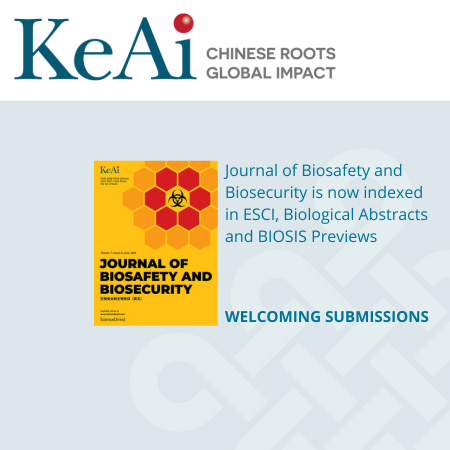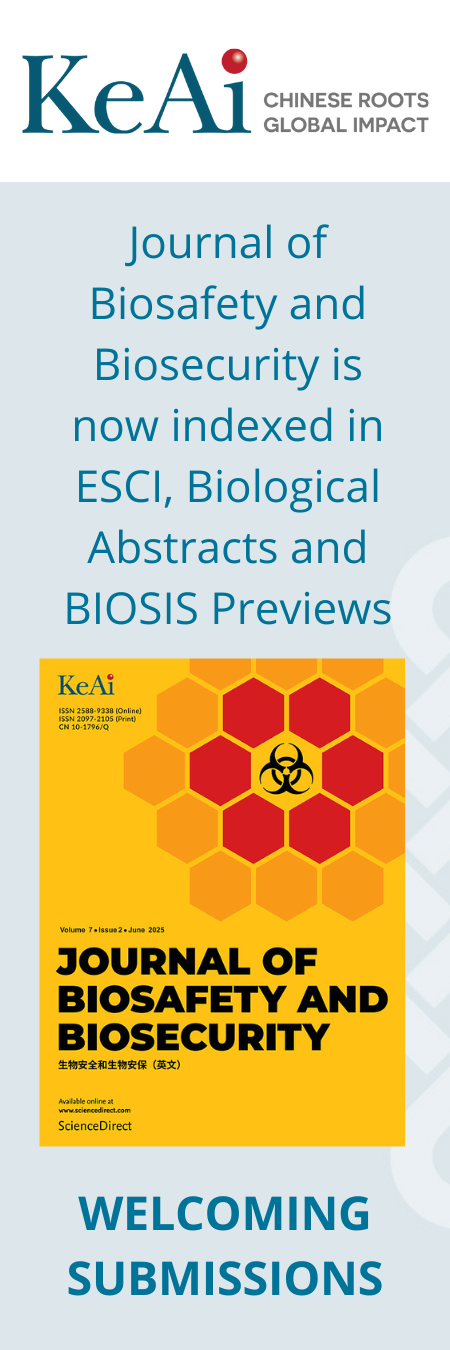Regulation of toxins and bioregulators under the Chemical Weapons Convention and the Biological and Toxin Weapons Convention
June 2024
In this paper we highlight how the apparent double coverage of toxins and bioregulators by both the Biological and Toxin Weapons Convention (BTWC) and the Chemical Weapons Convention (CWC) in fact masks...
Ethical framework on risk governance of synthetic biology
June 2023
Synthetic biology is an emerging multidisciplinary field that aims to design and construct new biological systems not found in nature. Whereas synthetic biology may yield tremendous benefits, it may...
Optimization of cryopreservation of pathogenic microbial strains
December 2020
The preservation of pathogenic microbial strains is of great significance for basic research in microbiology and utilization of microbial resources. Appropriate preservation methods can maintain high...
Biosafety and biosecurity in the era of biotechnology: The Middle East region
December 2022
Biotechnology became a paradigm-shifting science among all subfields of biology. The benefits of biotechnology have reached many practical fields, whether human health, animal, and/or agricultural....
Addressing poxvirus challenges in the Middle East to enhance biosafety and biosecurity measures
September 2024
The emergence and zoonotic transmission of poxviruses in the Middle East have been recognized as complex public health issues. Poxviruses, a vast family of DNA viruses, can infect many hosts, including...
Estimation methods of reproduction numbers for epidemics of varying strains of COVID-19
December 2024
The estimation methods of reproduction numbers and serial intervals are important in the early stages of infectious diseases. During the COVID pandemic, China implemented a dynamic zero-COVID policy...
Lessons for biosecurity education from the International Nuclear Security Education Network
December 2024
With the rapid advances in technology and life science, biological security is now at a defining moment. The mandate of the 2022 Biological and Toxin Weapons Convention 9th Review Conference emphasised...
Laboratory biosafety risk assessment: A critical component of avian influenza preparedness
March 2025
Human genome editing after the “CRISPR babies”: The double-pacing problem and collaborative governance
March 2023
How to ensure the safe, effective, and ethical use of emerging biotechnologies, such as clustered regularly interspaced short palindromic repeats (CRISPR)-based genome editing, is a global challenge....
Laboratory information management system for biosafety laboratory: Safety and efficiency
June 2021
Laboratory information management system (LIMS) has been widely used to facilitate laboratory activities. However, the current LIMSs do not contain functions to improve the safety of laboratory work,...
Synthetic biology: Recent progress, biosafety and biosecurity concerns, and possible solutions
March 2019
Synthetic biology is a new interdisciplinary research area that uses engineering principles as guidelines for biological investigation. With research goals to modify existing biological systems or to...
Challenges and recent progress in the governance of biosecurity risks in the era of synthetic biology
June 2022
Considerable progress has been achieved in basic research and the biotechnological application of biological sciences in recent years. Synthetic biology integrates systems biology, engineering, computer...
Biosafety laboratory risk assessment
September 2019
Biosafety laboratory risk assessment is a dynamic and systematic work. The scope of the assessment involves evaluation of pathogenic microbial hazards, experimental activities, facilities and equipment,...
Efficacy of commercial disinfectants Virkon®S and Microchem Plus against poliovirus
September 2025
The WHO Global Action Plan for Poliovirus Containment, 4th edition (GAPIV) describes the necessary conditions for the containment of poliovirus material in poliovirus-essential facilities (PEFs). PEF...
Evolutionary analysis of Omicron variant BF.7 and BA.5.2 pandemic in China
March 2023
On December 7, 2022, China adjusted public health control measures, there have been widespread of SARS-CoV-2 infections in Chinese mainland. As the number of infected people increased, the mutation...
A targeted vaccination strategy: Integrating vaccines into biosafety, biosecurity, and one health initiatives
March 2025
Vaccination has saved millions of lives and is regarded as one of modern medicine’s most important successes. Effective vaccination programs should be based on risk assessment that considers demographic...
Development and assessment of cutting-edge biotechnologies
March 2024
The emergence of advanced biotechnologies has intensified in recent years. The rapid development of these biotechnologies has had a wide and profound impact globally, with the majority on the frontier...
A brief history of the development of infectious disease prevention, control, and biosafety programs in China
March 2020
Safety of human beings has always been threatened by infectious diseases. In the process of fighting them, humans have continuously explored and researched the pathogens, transmission routes, prevention,...
Environmental pathways and drivers of antimicrobial resistance in waterborne Escherichia coli in Pakistan: a one health perspective
September 2025
Antimicrobial resistance (AMR) is a global health crisis requiring a One Health approach to integrate surveillance across sectors, particularly in water sources, to control its spread. Considering socioeconomic...
Current status and future challenges of high-level biosafety laboratories in China
September 2019
High-level biosafety laboratories are safe and secure platforms which integrate reliable containment, well-trained personnel, and specific biosafety manuals and practices to protect researchers from...
Biosafety and biosecurity
March 2019
With the profound changes in the international security situation, the progression of globalization, and the continuous advancement of biotechnology, the risks and challenges posed by major infectious...
Development of and prospects for the biological weapons convention
June 2022
Biological weapons are used in wars to wound or kill people or animals and destroy crops with pathogenic microorganisms such as bacteria and viruses, as well as toxins and other biologically active...
Mosquito-borne diseases: Assessing risk and strategies to control their spread in the Middle East
March 2024
Mosquito-borne diseases (MBDs), like malaria and mosquito-borne viruses (MBVs), have caused the deaths of millions of people. Their threat resides in the variety of transmission modes that they possess,...
Deliberate release: Plague – A review
March 2020
Yersinia pestis is the causative agent of plague and is considered one of the most likely pathogens to be used as a bioweapon. In humans, plague is a severe clinical infection that can rapidly progress...


